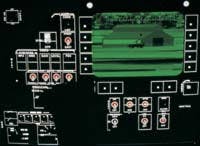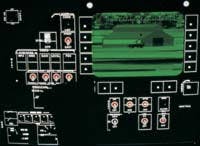By John McHale
ALAMEDA, Calif. — Engineers at EER Systems Inc. in Chantilly, Va., are using video technology from RGB Spectrum in Alameda, Calif., to upgrade a training simulator for the U.S. Army's OH-58D Kiowa Warrior scout and light-attack helicopter.
The new simulator — the Cockpit Procedures Trainer, or CPT — is a mockup of the Kiowa Warrior cockpit that uses RGB Spectrum's SuperView 500 video processor to display several different images simultaneously from video and computer inputs, RGB Spectrum officials say. The simulator is part of the Crew Station Mission Trainer (CSMET) program.
"We chose RGB's SuperView processor because it is the only product that does the job," says Greg Malen, EER System's project engineer. "Our needs were difficult to meet. We required support of a variety of inputs, with differing resolutions and scan rates, and the ability to display these images full screen or in multiple overlaid windows that we could move around, resize, and switch back and forth. SuperView does many clever things with its flexible image manipulation and overlay capabilities. And it is simple to use."
The Kiowa Warrior simulator contract is an example of how RGB Spectrum's military business is continuing to grow despite today's tough economic conditions, says Bob Marcus, president and chief executive officer at RGB Spectrum. Last year when the economy was in good shape, RGB Spectrum's audio/visual business, which is mostly commercial, was growing faster than the military, he explains. Now, with the economy slow, the military is still strong and growing a little faster than the company's audio/visual business, Marcus says.
The military market is not always a constant, but it is reliable and does not have the extreme ups and downs of the commercial world, says Bob Marcus, president and chief executive officer at RGB Spectrum. RGB Spectrum's military expertise falls under simulation and command and control and "right now that's where the military is spending its money," he says.
This enhanced generation of flight simulators is realistic and provides the actual readout images pilots use to fly and fight in combat, company officials say. Pilots will now see the real computer-generated and video images displayed on the cockpit multi-function displays (MFDs) used in combat.
"It was essential that we develop a system that provided an accurate, realistic simulation of the MFD images pilots used in combat," says Dave Sjuggerud, EER Systems project manager. The simulator has to display a variety of video and computer-generated inputs covering a variety of battlefield simulations including combat exercises, flight and operations training, target acquisition, and weapons deployment."
The SuperView's video inputs include Mast Mounted Sight infrared and video target acquisition signals coming from a video camera and an infrared thermal imaging sensor mounted on top of the helicopter's rotor, RGB Spectrum officials say. The SuperView processor combines these video signals with computer-generated images containing navigation, flight attitude and altitude, flight speed, ordnance data/logistics, and other command-and-control information derived from thousands of pre-stored visuals.
The SuperView processor — a Motorola 68032 embedded processor — displays these visuals in multiple, overlaid windows on the master control console used by the pilots, says Bob Marcus, president and chief executive officer at RGB Spectrum.
The pilot can view any of the input visuals full screen or in several different overlain windows and have the same image switching capability that they will use in combat. The newly deployed simulator's MFD display works the same as in actual battlefield conditions to depict the most realistic battlefield simulation, company officials say.
The SuperView 500 chosen for this program was taken right off the shelf, Marcus says. There was a time when everything got tweaked to meet customers' specific needs, he adds. However, there have now been so many tweaks that now the full range of RGB Spectrum's potential customers can what they need from the product right off the shelf, Marcus claims.
"SuperView's image quality is great," EER Systems's Sjuggerud claims. "We have had prior experience with the SuperView in our prior simulation program with excellent success. Simply put, it is the best there is."
The SuperView multi-input display processor accepts as many as 10 real-time inputs.




